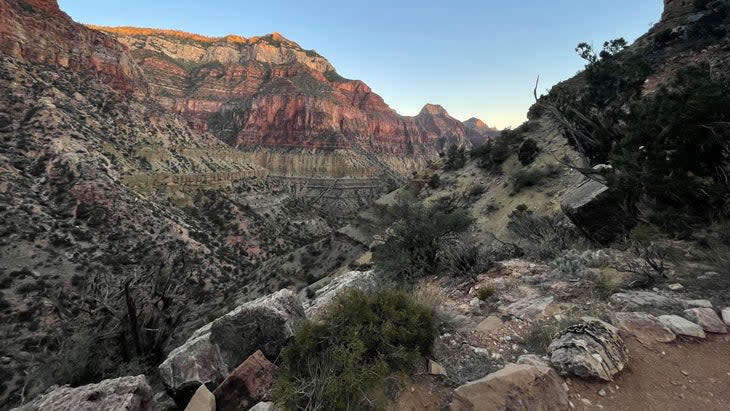This is the Gear Hiker Katie Brown Used to Set a New Arizona Trail FKT
This article originally appeared on Backpacker
In the spring of 2022, emergency room nurse Katie Brown set the self-supported Fastest Known Time on the Arizona Trail, beating Heather "Anish" Anderson's 2016 record by nearly two days. On the northbound attempt, Katie drew on her backpacking experience as a Triple Crowner to winnow down her pack weight to the bare minimum. We caught up with Brown to talk route-planning, her favorite gear from the trip, and a few packing strategies that didn't pan out.
The Route
Arizona is known for its heat, but thanks to the Arizona Trail's high-elevation, 790-mile route from Utah to Mexico, the nights are surprisingly cold. Snow can linger late into the year north of the Grand Canyon and water can be tough to find throughout. Unlike most other long trails, the Arizona Trail has two separate seasons in the Spring and the Fall. Both seasons have their challenges. Backpackers in the fall have more trouble finding reliable water and are at risk of encountering heavy rain or snow. Springtime hikers often encounter lingering snow in the north and heat in the south.
The Plan
Planning and weather considerations played a large role in Brown's kit: By leaving on April 28-- later than is common--she was able to carry less cold-weather gear and avoid any lingering snow north of the Grand Canyon. The decision to tackle the trail northbound meant she would face the most rugged, technical terrain of the Sky Islands--mountains abruptly rising from the desert floor--and the Sonoran Desert first, before the tamer rolling plateaus of northern Arizona.
Despite the strategic timing, a single gear list to cover nearly 800 miles is still a challenge. To transform her traditional backpacking gear to an FKT-worthy gear list, Brown cut weight nearly everywhere. "I packed taking into consideration how much I was willing to suffer without putting myself in danger," she says. Her zero-degree sleeping bag became a 30-degree quilt, her usual freestanding tent became a simple tarp, and the 50-liter Osprey backpacking pack was replaced with a small, 24-liter fastpack. Despite some uncomfortably cold nights and two borderline unbearably hot days in the southern desert, the gear remained the same throughout the 17-day record attempt.
What Worked
The weather was so good that Katie's gear list--especially her 30 degree Katabatic quilt--kept her warm nearly all the way to Utah. When the temperature plummeted on the Kaibab Plateau, Brown pulled out her unused Zpacks Pocket Tarp and wrapped it around herself as an extra layer.
"The tarp proved very effective, and I cursed myself for not utilizing it on the previous cold nights. I probably would have been much happier." She brushed off the idea of adding warmer gear or a more substantial sleeping pad (her Gossamer Gear 1/8th-inch foam pad has a minimal R-value of .5), noting that the tarp would have been enough for those especially cold nights if she had thought of it sooner.
In temperatures that ranged from 23- to 95-degrees, Katie said she relied more than expected on her Arc’teryx Taema sun hoodie. It shielded her from harsh exposure in the south and was an extra layer of warmth in the north. The versatility, breathability, and comfort made it the perfect daily layer throughout the 17 day record. Her favorite piece of gear? A Kula Cloth pee rag, for its simplicity and function.
What Didn't
Apart from a run-in with hungry rodents who shredded the straps on her Pa'lante Packs Joey, most of Brown's kit worked as planned. When asked what, if any, gear-related changes she might make in the future, Brown discussed her food strategy. "Cold soaking just sucks." The plan to slowly rehydrate beans and rice in an old peanut butter jar filled with cold water was abandoned around mile 200. The hot and exposed climbs of the south demanded more than slimy, uncooked calories. After choking down a cold meal in the Mica Mountains, she dumped all her dried food and filled the calorie void with extra bars, crackers, chips, and candy.

Brown's gear list considered weight and functionality above all else. With the goal of traveling as fast as possible, every ounce was considered. Here is what Brown carried on her Arizona Trail record-setting hike.
Item | Model | Weight |
Backpack | 14.8 oz | |
Fanny Pack | Pa'lante Packs Fanny Pack | 2 oz |
Groundcloth | 3 oz | |
Quilt | 18.4 oz | |
Sleeping Pad | 2 oz | |
Shelter | 6 oz | |
Down Jacket | 7.8 oz | |
Rain Jacket | 6 oz | |
Shorts | 2 oz | |
Base Layer | 3 oz | |
Sunshirt | 3 oz | |
Socks | 1 oz | |
Shoes | 30 oz | |
Clothes | Sports Bra | 2.8 oz |
Beanie | Beanie | 1 oz |
Gloves | Gloves | 1 oz |
Water Filter | 3 oz | |
Bottles | Smartwater bottles x2 | 1 oz |
Food | PB Jar | 1 oz |
Utensil | 1 oz | |
Reservoir | 1 oz | |
Phone | 4 oz | |
Watch | 1 oz | |
Battery | 6 oz | |
PLB | 4 oz | |
Headlamp | 1.2 oz | |
Poles | 12.5 oz | |
Hygiene | 0.4 oz | |
Misc | Misc | 8 oz |
Base Weight | 7.5 lbs | |
Worn Weight | 1.2 lbs | |
Total Weight (without food or water) | 8.7 lbs |
For exclusive access to all of our fitness, gear, adventure, and travel stories, plus discounts on trips, events, and gear, sign up for Outside+ today.

